Pictures of my project in Pindo Deli
Pulp
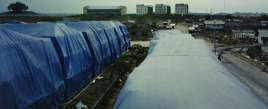
|
Wood is the most important raw material for producing paper. Actually, it is the wood's cellulose fibres that is intersting. These fibres keep the wood together and must be seperated. The fibres, when seperated, is called pulp. The pulp is transported to the paper mill and first stored outside, here under the blue covers. |
| The pulp is then brought into a pulp storage from where it can easily be dispensed as needed. |
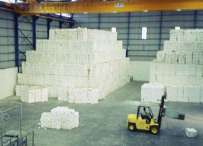
|
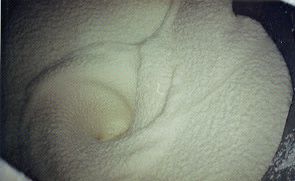
|
Pulp is mixed with water (in a pulp beater) into a slurry. The slurry is further refined and goes then to the paper machine. |
The paper machine
|
The paper machine is huge. Basically, the paper machine presses and dries the slurry, thus producing the paper.
The 'back' side is on the left, the 'front' side on the right. |
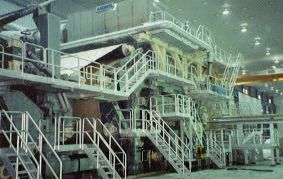
|
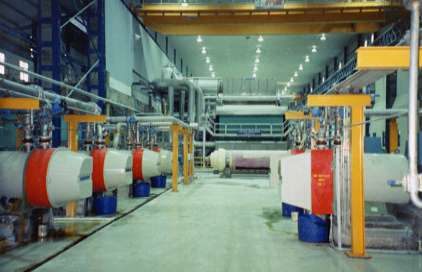
|
Here's a picture of the paper machine from the 'back'.
The opposite side (the front) is where the paper actually comes out and is wound up onto big rolls (some 5.5 meters wide and up to 2.5 meters in diameter). |
The big rolls
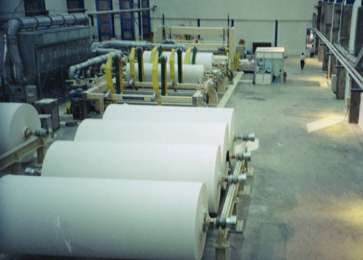
|
The big paper rolls that come out of the paper machine go to a buffer area from where they go to the cutter.
The buffer area holds the four big rolls in the left lower corner while the cutter is seen in the middle of the upper half of the picture. |
|
Here's another view of the buffer area and the cutter.
In the upper right corner, just above the winder, there's a crane in action that moves the big rolls from the paper machine to the buffer area, and from the buffer area to the winder. |

|

|
Some workers of the mill sitting on a big roll.
And yes, I'm the one up in the middle. |
|
Sometimes, the paper machine produced a bad roll (or paper of insufficient quality).
In such a case, the paper was manually cut from the big roll which is what the guy sitting on the role does. After removing the paper, it is thrown again to the pulp and fed to the paper machine. |

|
The winder
|
This pictures shows the winder.
On the left side, a big role is being unwound. On the right side (not clearly visible), the paper is cut into narrower lanes and then wound onto smaller (both in diameter and width) roles. |
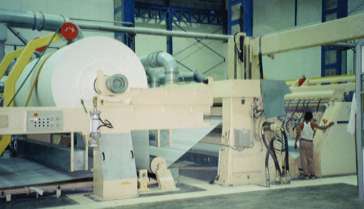
|
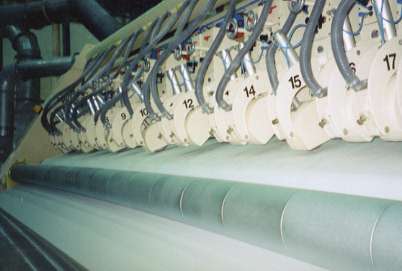
|
Here's the part that wasn't very well visibly in the picture above. Those thingies labeled with numbers are blades that cut the paper of a big role into narrower lanes. |
|
As soon as a small role is wound up, it is brought onto a conveyor belt that carries it to the wrapper.
See also the belt conveyor after the fire. |
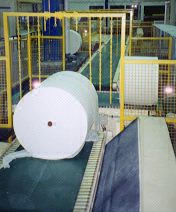
|
Wrapper

|
The smaller roles (cut at the winder) are wrapped into a transparent plastic film.
The employee is changing a finished film role here. When the wrapper is working it does two things: it circulates the yellow-black parts around the paper roll and wraps the role into the film. It also revolves the paper role around the role's axis so that the entire role is wrapped in. After wrapping the role, the role's weight and diameter are measured and it is then conveyed to the toppler. |
Toppler

|
In order to pile up the role in the storage, the role needs to be toppled.
That's what the role topler does. After toppling the role, a clamp truck will move the role into the storage. |
Storage
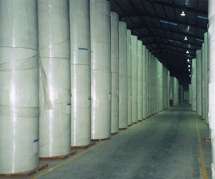
|
The roll storage is the place where the roles wait to be transported to the customers.
The entire roll storage could store paper that weighed 4000 tons. See also the roll storage after the fire. |
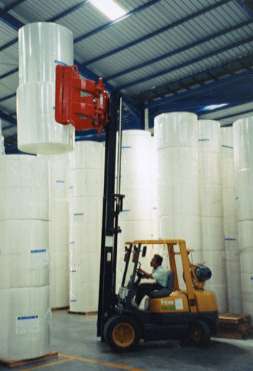
|
The clamp trucks were used to move the roles in the storage around and to move them into the trucks that brought them to the customers of the paper mill. |

|
Inhouse converting

|
Not all paper went to customers. Some paper was inhouse converted into tissues.
This machine (as well as the guy working on it) is from Germany and produces tissue handkerchieves. |